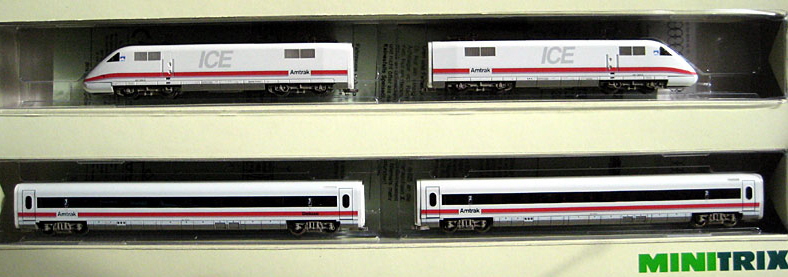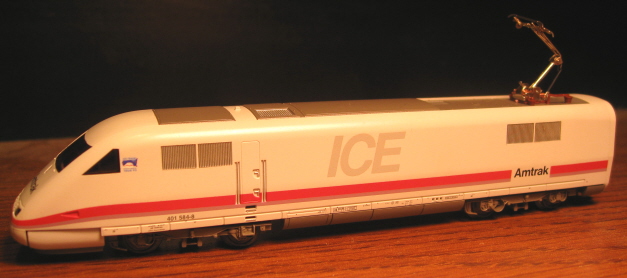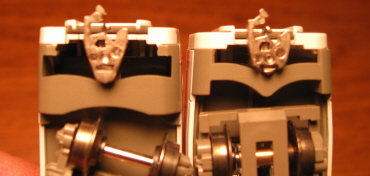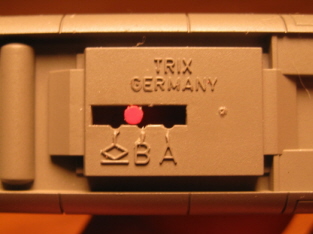

Introduced: 1994
Minitrix ICE trains have been around since 1985 (in DB livery), but they make it into the encyclopedia here by virtue of this 1994 Amtrak special edition set. These models are basically the same as Minitrix's DB ICE 1 train, excepting that the DB logo has been replaced by an Amtrak logo. This was a one-time offering by Minitrix, apparently commemorating the demonstration runs the ICE train made in the United States back in 1992. I have no idea what the production numbers might have been, but since I've only come across one of these sets in ten years of eBaying, I'm assuming they're relatively rare.
These models ("ICE 1 With Amtrak Lettering") were introduced by Minitrix at the Nuremberg Toy Fair in 1994. A so-called "beginner's set" (catalog #11025) included two end units (one powered, one dummy), one coach, track, switches and a transformer. In addition to said full-blown train set, the above pictured "plain" set (catalog #12899) was also available.

The powered unit's chassis is a big hunk of metal and quite hefty. The motor is an open-sided, straight-wound 3-poler. There are no flywheels. All four axles are geared and all gearing is metal. Wheel flanges are oversized, so forget about running this train on anything like Code-55 rail (the same applies to all the rest of the units). The inner two wheels on the rear truck are equipped with traction tires. There is no specific provision for DCC. All of that wiring is routed to a complex slider switch / PC board mounted to the bottom of the chassis (more on that in a moment).

The dummy unit is pretty much identical to the powered unit - just lacking the motor, drivetrain, and a big hunk of the metal chassis. Both end units have sprung / moveable / functional pantagraphs.

The pickup scheme is kind of weird. The dummy end unit picks up current from both rails (using all eight wheels). However, the powered unit only picks up current with the three (non-traction tire) wheels on the right side. Current is collected via wheel-back wipers and, rather ingeniously, transferred from the dummy unit to the powered unit through the metal couplers. The upshot of all that is that for positive and negative current to reach the motor, both units must be on the rails... and pointed in opposing directions... and coupled.

This particular feature led to quite a bit of confusion on my part, what with me sitting there wondering why in the heck my motorized unit didn't move when I twisted the throttle. Well, duh, I hadn't hooked anything else up to it. Consequently, it sat there with only one rail's worth of power, patiently waiting for me to (finally) read the instructions and get my $hit together.
Interestingly enough, there is also a slider switch on the bottom of each end unit, allowing one to set them to gather one rail's worth of current from overhead catanery -

When not in the "catanery" setting, said slider determines the behavior of the bi-directional lighting for each end unit. When set to the "A" position, an end unit will display white lighting when moving forward and red lighting when moving backward (and vice-versa when set to the "B" position). And if both are set the same way (both "A" or both "B"), the powered unit will not respond to the throttle at all (yet another "duh" lesson learned through frustrating trial and error).
Overall performance is quite good (if unspectacular). Throttle response is smooth at all levels and pickup is excellent. The entire train easily navigates sharp curves - right down to 9.75" radius (although it looks a little strange whilst doing so). Pulling power is adequate, although it does tend to slow down rather drastically when faced with relatively steep (2%) grades. Slow speed creep is very nice, whereas the top-end speed seems excessive. And as mentioned previously, the wheel flanges are oversized (most annoying). But I guess my main complaint here (and the reason I'm not handing out any "A" ratings) is the fact that the thing just plain makes a lot of noise - IE, electric razor syndrome.
Looks-wise, these are respectable enough models. However, I have to say that Fleischmann's Amtrak ICE train (released around the same time) has considerably finer detailing. Also, I'm told that Minitrix's version does not reproduce the asymmetric position of the door handles on the end units correctly (for whatever that's worth).
On a side note, I really have hand it to Minitrix for the ingenious couplers. These are far and away the best "close coupling" couplers I have ever encountered in N scale. Coupling is easy (slide two cars together until they "click") and uncoupling is even easier (lift one of the cars up and it uncouples). Take that Bachmann, Fleischmann (et al).
To remove the shell from one of the end units, simply pry the sides apart a bit to free the side clips, and then apply a bit of upward pressure. It should pop off relatively easily at that point.

To remove the shell from one of the coaches, slide the little nob on the bottom to the "Auf" position. The shell should lift off readily at that point. After putting the shell back on, slide the nob back to the "Zu" position to lock it in place. How wizard is that?!
Grade: B (mainly 'cuz of the noisy mechanism)